Simulation: New Driving Force Behind Additive Manufacturing
Simulation replaces trial-and-error processes and a reliance on tribal knowledge to pave the way for widespread AM adoption for production use cases.
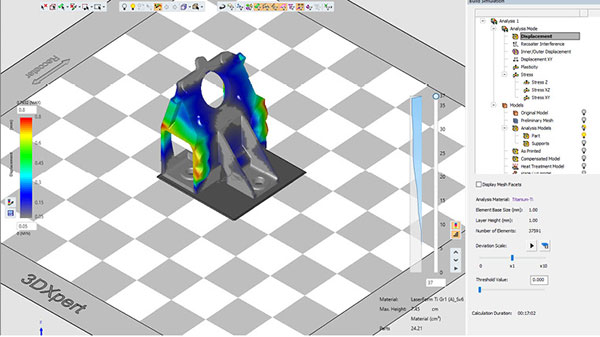
By simulating the build process with 3DXpert, engineers can predict issues that might result in build failure or damage to the printer before sending the part to print. Image courtesy of 3D Systems.
Latest News
April 15, 2021
Trial and error—it’s been the go-to practice for additive manufacturing (AM) experts, who typically take months and churn through reams of expensive materials trying to iterate and troubleshoot in the quest to output a perfect part. Simulation, long a fixture in design workflows that help cut back on physical prototyping, is now rearing its head on the AM scene. An emerging category of AM-specific simulation tools are providing a way for design, manufacturing and process engineers, along with others in the production workflow, to work out the kinks and optimize parts for AM output without having to rely on time-consuming, experimental work performed by a small group of specialized experts.
“This trial-and-error process has to change if the industry was really going to take off and AM is to going to have the impact that it could have,” says Brent Stucker, distinguished engineer in AM at Ansys. “You can’t have every new user learn on the job—you need something that will help teams take advantage of best practices immediately, and simulation is key. It’s the great equalizer in allowing anyone from any background to do what they want to do in AM.”
Traditional simulation tools like finite element analysis (FEA) and computational fluid dynamics (CFD) can help engineers design more AM-friendly parts while newer variations like generative design software turn out optimized and organic shapes based on key parameters that could only be output with AM technologies.
However, these simulation offerings are limited in their ability to tackle AM-specific challenges such as determining potential part deformation during a build or as-built component performance, which is governed by material properties and the layer-by-layer AM process. These scenarios require a new level of computational modeling and horsepower.
As costs for sophisticated AM technologies—metal 3D printing, for example—drop, new categories of simulation tools and methodologies are being introduced to tackle these problems and position AM as a viable alternative to conventional manufacturing practices.
With companies moving beyond prototyping into production-scale 3D printing use cases, there is growing emphasis on the need to print the part right the first time without wholesale reliance on tribal knowledge and free from the costly trial-and-error exercise.
The requirement has sparked interest in a new class of AM-specific simulation software ranging from tools that optimize build plate layout and support placement to more sophisticated capabilities such as design identification and recalibration in the virtual world to address part deformation before the print runs.
“Build failures are extremely common—there could be upwards of 10 failures on production-scale parts, which run into costs of tens of thousands of dollars,” says Erik Denlinger, principal researcher on AM simulation at Autodesk. “The ability to provide insight into if and how a part might fail is extremely valuable.”
Where Simulation Can Help
AM simulation software can help predict and prevent a range of 3D printing failure modes, but some more prevalent issues include extensive distortion, support structure issues and interference with the re-coater blade—a common issue with metal AM technologies.
AM simulation software is also helping teams optimize the build environment, whether to maximize the number of parts per print, orient support structures effectively, direct part placement to ensure the desired performance characteristics or eliminate cracking and other defects.
From a broader standpoint, simulation can have further impact on the AM process. Simulation tools can aid in parts certification to reduce the amount of destructive physical tests, help companies determine the best part candidates for AM processes and automatically tune the machines based on individual part characteristics. Over time, new simulation packages are emerging that function as in situ print monitoring tools, and are able to automatically recalibrate and adjust machines in process to avoid print failures.
“How 3D printer manufacturers optimize the process is the secret sauce that lets them accurately produce parts from machines, but it’s a peanut butter spread of parameters that give the best balance for the widest range of parts,” says James Berlin, senior software product manager, manufacturing and alliances, at Stratasys. “Simulation gives us the tools to look at parts at an individual level and make decisions.”
Stratasys has a long-standing partnership with MSC Software, part of the Hexagon Group, to collaborate on AM material and process modeling. The company is working with MSC’s e-Xstream Engineering group to create tighter integration between its platforms and Digimat, a multi-scale material and structure modeling platform that can predict behavior for a large mix of composite materials. Simufact Additive, also from Hexagon, focuses on predicting distortion and automated distortion compensation for metal binder jetting sintering technology.
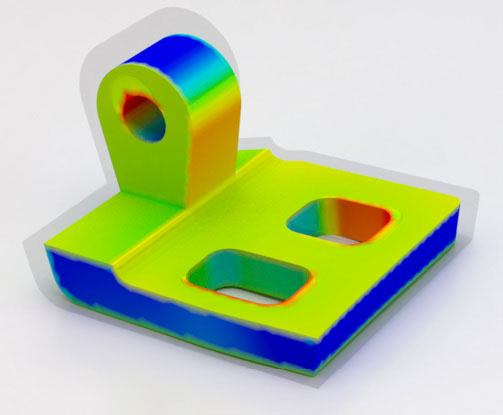
Rival 3D Systems has been developing AM-specific simulation capabilities as part of its 3DXpert AM software. In addition to the ability to position and modify part orientation, optimize structures with lattice, and infill features and analyze design supports, 3Dxpert has simulation capabilities for predicting issues that might result in build failure or printer damage. The software also can create a compensated geometrical model to offset deviations created during printing.
“Having CAD, simulation and slicing capabilities allows us to further close the loop on design to print,” says Jeph Ruppert, director, application innovation group at 3D Systems. “It gives users full control down to a single laser spot in the way the build process goes.”
Many new AM-specific tools take a completely different approach to simulation because it’s been too computationally expensive to simulate AM—specifically the micro-structure behavior on materials and the AM process. Autodesk’s answer is multi-scale modeling methodologies as part of its Netfabb AM suite and simulation extensions for the Fusion 360 software.
The technique breaks the process into two pieces—the small-scale simulation (1x1 mm, for instance) at high resolution for the part and material; the learnings from that model are then applied to the rest of the build volume as a way to circumvent the computational expense, Denlinger says. Autodesk’s solutions also leverage adaptive meshing, whereby the solver interrogates the geometry at every level to determine whether the part calls for solving at high resolution or a lower resolution, coarser mesh.
Autodesk Build delivers features for full production control, including positioning on the build plate and supports. Autodesk Simulation Extension, the process simulation module, focuses on predicting distortion, suggesting geometry resolution fixes and addressing re-coater blade interference.
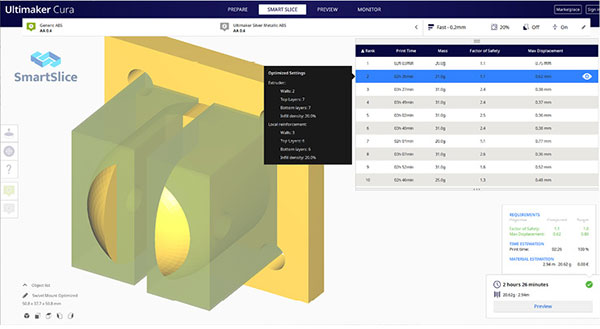
Teton Simulation is blazing new ground with simulation capabilities aimed at print parameter optimization and validation based on end-use requirements for Fused Deposition Modeling (FDM) AM systems. SmartSlice is a plug-in that integrates into Ultimaker Cura, evaluating geometries and automatically adjusting print parameters such as infill patterns, density, layer height and wall thickness to optimize part production and ensure the final output meets performance demands.
“To create a model by hand without the use of simulation built for AM can be daunting if not an impossible task,” says Rick Dalgarno, Teton Simulation’s director of operations and alliances.
Companies like Siemens Digital Industries Software, Ansys and Hexagon’s Manufacturing Intelligence division are pursuing an end-to-end strategy as it relates to integrating simulation into AM workflows.
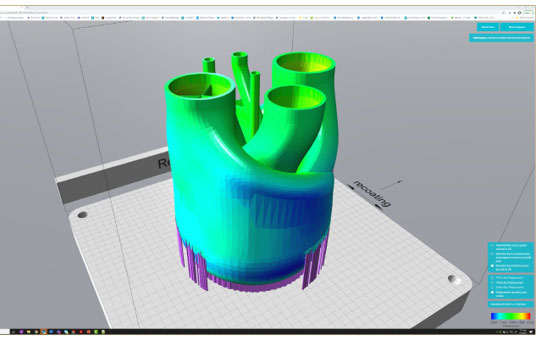
For Siemens, simulation tools will play an upfront role in determining how to orient a part in a printer for the least amount of distortion and predict the microstructure and macrostructure behavior of parts to direct material deposit or identify gaps and overheating areas on the build plate.
Simulation also can be tapped predict material properties from the manufacturing process applied or to map out and plan AM factories, according to Aaron Frankel, vice president of additive manufacturing program at Siemens.
As part of its portfolio of products, Siemens offers NX Build Optimizer for orienting parts and NX Path Optimizer, technology for powder bed fusion parts that combines physics-based simulation and machine learning to minimize overheating challenges that cause inconsistencies in part quality. The Simcenter3D simulation portfolio serves up various capabilities, including process capabilities for predicting and addressing distortion of metal parts and multi-scale modeling capabilities for predicting failure in advanced materials. Siemens is also partnering with a range of AM printer providers, including EOS and Evolve, to optimize its simulation tools for specific platforms and AM technologies.

Ansys’ vision for end-to-end AM simulation covers design for AM (DfAM), build setup, process simulation, materials analysis, data acquisition and management, and part qualification.
On the materials side, the Additive Science platform performs material analysis to predict meltpool dimensions based on machine parameters and material, porosity grain size and orientation, and thermal sensor simulation to evaluate thermal properties during printing. Though this portfolio of tools is aimed at simulation and materials experts, Ansys also offers Additive Print, a set of core push-button AM simulation capabilities aimed at non-experts.
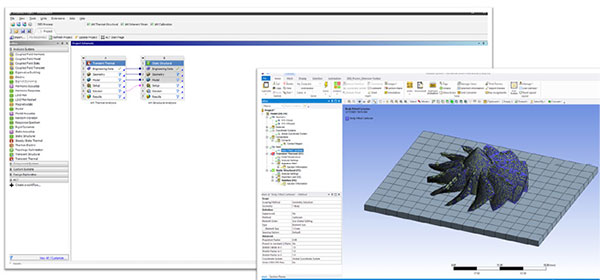
“We aim to give everyone across the spectrum value from simulation with an interface that meets them where they are,” Stucker says.
The Road Ahead
Though AM simulation tools have potential for streamlining and perfecting the 3D printing process, the trick is to successfully integrate the software into engineering workflows, which is no easy feat.
For one, companies need to build up trust in the accuracy of simulation methods and educate users on their potential benefits. The complexities of simulation and AM processes can make for a very complicated platform, so companies need to do their part to make the software accessible to a wider range of users.
“People work in silos—design people don’t talk to manufacturing people,” says Mathieu Pérennou, strategy director, additive manufacturing, for Hexagon’s Manufacturing Intelligence division. “We’ve developed products that can be used by process people on one side as well as made it simple enough for someone without deep knowledge of AM to set up manufacturing processes and check whether their design makes sense.”
In addition, because AM creates a part from the inside out, it flips the manufacturing process on its head, which requires a realignment between design and manufacturing functions.
“Design simulation experts lock down performance in CAD, but with AM, it’s not locked down until you define the steps of manufacturing,” says Stratasys’ Berlin. “There’s work to be done reconciling redistributed responsibilities between someone designing parts and someone manufacturing parts. Simulation needs to bridge that gap and take into account the intent of both areas.”
More 3D Systems Coverage
More Ansys Coverage
More Autodesk Coverage
More Hexagon Coverage

More Hexagon MSC Software Coverage
Subscribe to our FREE magazine, FREE email newsletters or both!
Latest News
About the Author
Beth Stackpole is a contributing editor to Digital Engineering. Send e-mail about this article to DE-Editors@digitaleng.news.
Follow DE







